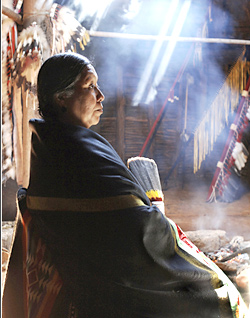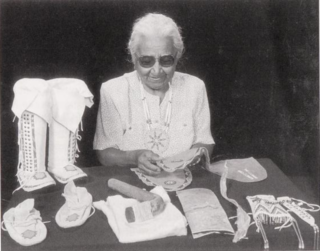Related Research Articles

The Indian Territory and the Indian Territories are terms that generally describe an evolving land area set aside by the United States Government for the relocation of Native Americans who held aboriginal title to their land. In general, the tribes ceded land they occupied in exchange for land grants in 1803. The concept of an Indian Territory was an outcome of the US federal government's 18th- and 19th-century policy of Indian removal. After the American Civil War (1861–1865), the policy of the US government was one of assimilation.

Caddo County is a county located in the U.S. state of Oklahoma. As of the 2010 census, the population was 29,600. Its county seat is Anadarko. Created in 1901 as part of Oklahoma Territory, the county is named for the Caddo tribe who were settled here on a reservation in the 1870s. Caddo County is immediately west of the seven-county Greater Oklahoma City metro area, and although is not officially in the metro area, it has many economic ties in this region.

Anadarko is a city in Caddo County, Oklahoma, United States. The city is fifty miles southwest of Oklahoma City. The population was 6,762 at the 2010 census, a 1.8 percent gain from 6,645 at the 2000 census. It is the county seat of Caddo County.

Kiowa people are a Native American tribe and an indigenous people of the Great Plains of the US. They migrated southward from western Montana into the Rocky Mountains in Colorado in the 17th and 18th centuries, and finally into the Southern Plains by the early 19th century. In 1867, the Kiowa were moved to a reservation in southwestern Oklahoma.

The Plains Apache are a small Southern Athabaskan group who live on the Southern Plains of North America, in close association with the linguistically unrelated Kiowa Tribe. Today, they are centered in Southwestern Oklahoma and Northern Texas and are federally recognized as the Apache Tribe of Oklahoma.
The American Indian Exposition, held annually during the first full week in August at the Caddo County Fairgrounds in Anadarko, Oklahoma, is one of the oldest and largest intertribal gatherings in the United States. Sponsored by fifteen tribes, representatives from up to fifty other tribes participate in any given year.

Tommy Wayne Cannon was an important Native American artist of the 20th century. An enrolled member of the Kiowa Tribe with Caddo and French descent, he was popularly known as T. C. Cannon.
The Kiowa Six, previously known as the Kiowa Five, is a group of six Kiowa artists from Oklahoma in the early 20th century, working in the "Kiowa style". The artists were Spencer Asah, James Auchiah, Jack Hokeah, Stephen Mopope, Monroe Tsatoke and Lois Smoky.
Spencer Asah was a Kiowa painter and a member of the Kiowa Six from Oklahoma.
Monroe Tsatoke (1904–1937) was a Kiowa painter and a member of the Kiowa Six from Oklahoma.
Stephen Mopope (1898–1974) was a Kiowa painter, dancer, and Native American flute player from Oklahoma. He was the most prolific member of the group of artists known as the Kiowa Six.
Lois Smoky Kaulaity (1907–1981) was a Kiowa beadwork artist and a painter, one of the Kiowa Six, from Oklahoma.
The National Hall of Fame for Famous American Indians, established in 1952 in Anadarko, Oklahoma, is part of a complex representing American Indian life. The National Hall of Fame has bronze busts mounted outdoors. The Hall of Fame, which has free admission and is staffed by volunteers, features busts of 41 Native Americans from various tribes to honor their contributions and place in American history.

Vanessa Paukeigope Santos Jennings is a Kiowa/Kiowa Apache/Gila River Pima regalia maker, clothing designer, cradleboard maker, and beadwork artist from Oklahoma.

Richard Aitson is a Kiowa-Kiowa Apache bead artist, curator, and poet from Oklahoma.
David Emmett Williams was a Native American painter, who was Kiowa/Tonkawa/Kiowa-Apache from Oklahoma. He studied with Dick West at Bacone College and won numerous national awards for his paintings. He painted in the Flatstyle technique that was taught at Bacone from the 1940s to the 1970s.
Doris Littrell is a retired Native American art dealer and gallery owner from central Oklahoma. From 1955 to 2009, she developed and expanded the market for Oklahoma Native art through her gallery, travels, and raising the visibility of Oklahoma Indian painters both inside and outside of the state. Littrell exerted a major impact upon the careers of Mirac Creepingbear, Doc Tate Nevaquaya, Merlin Little Thunder, and Virginia Stroud, among others.

Southern Plains Indian Museum is a Native American museum located in Anadarko, Oklahoma. It was opened in 1948 under a cooperative governing effort by the United States Department of the Interior and the Oklahoma state government. The museum features cultural and artistic works from Oklahoma tribal peoples of the Southern Plains region, including the Caddo, Chiricahua Apache, Comanche, Delaware Nation, Kiowa, Plains Apache, Southern Arapaho, Southern Cheyenne, and Wichita.

Alice Littleman was a Kiowa beadwork artist and regalia maker, who during her life time was recognized as one of the leading Kiowa beaders and buckskin dressmakers. Her works are included in the permanent collections of the National Museum of Natural History, the National Museum of the American Indian, the Southern Plains Indian Museum, and the Oklahoma Historical Society.
References
- ↑ "Anadarko, Oklahoma: Indian City, U.S.A." Leisure and Sports Review (LASR). Retrieved 2012-12-02.